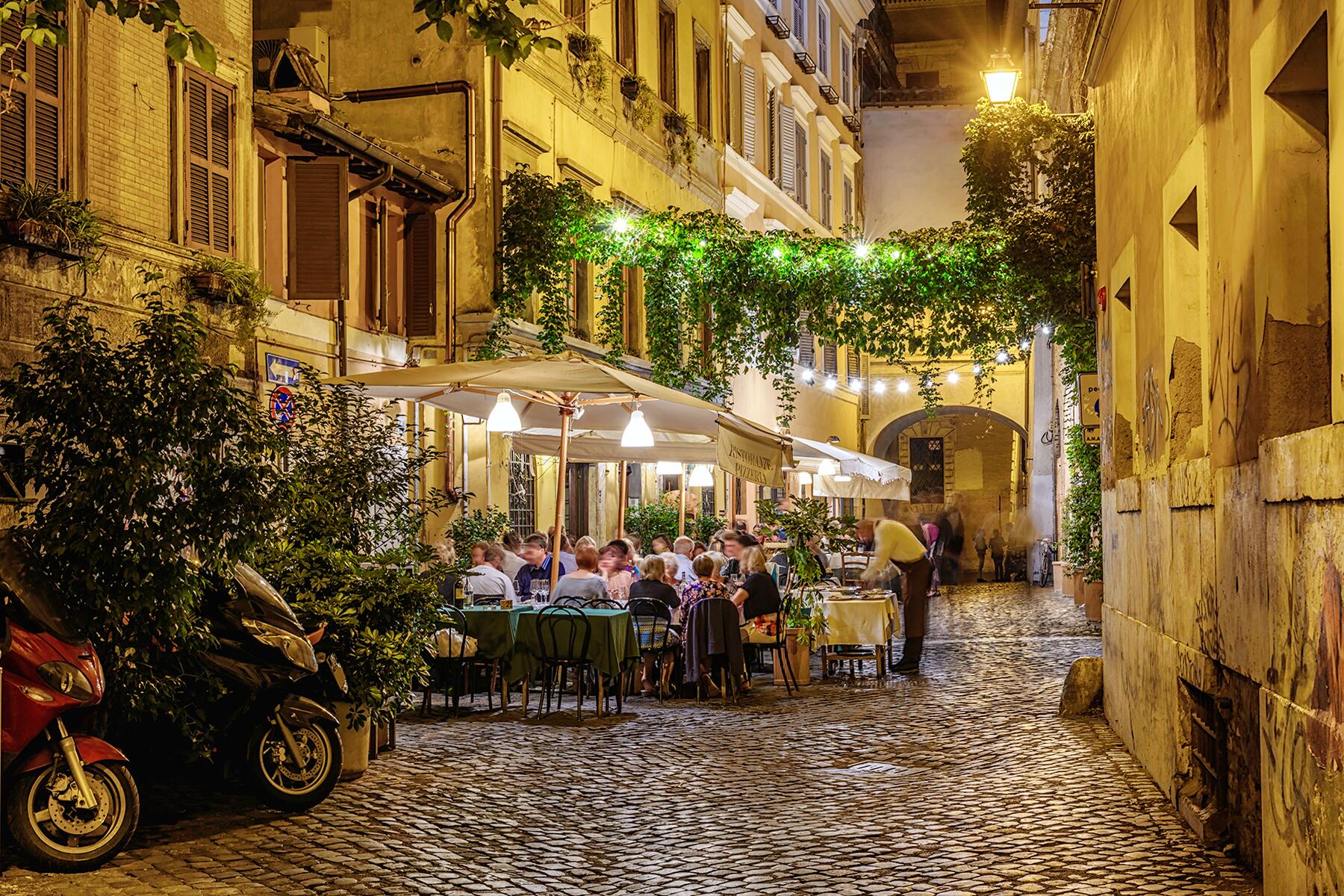Skip pizza, carbonara, and Caprese next time you’re in Italy and try these surprisingly tasty regional dishes instead.
The concept of “Italian cuisine” is a myth that belies the myriad of hyperlocal products and dishes abounding from north to south of the country. Regions, cities, and even villages have their own unique cuisines that have developed autonomously thanks to the diversity of terrain and the influence of other cultures who ruled sections of the country before it united in 1861. From offal fried in lard to seafood and hardboiled egg sculptures, here are some of Italy’s most unusual and surprisingly tasty regional specialties.
Top Picks for You
Bagna Cauda
WHERE: Piedmont
Translating literally as “hot sauce,” this is the northern Piedmont region’s answer to fondue, only far more pungent. The punchy flavors are made by slow-cooking heaps of garlic with anchovies and olive oil until it becomes a thick sauce. This is served over a flame to keep it warm, and diners dip in raw and cooked vegetables like peppers, celery, and spring onions. Thought to originate in the 16th century, the strongly savory dish must be accompanied by one of Piedmont’s powerful red wines, Barolo or Barbaresco.
Pasticcio
WHERE: Ferrara
This extraordinary pasta pie originated as a table centerpiece at aristocratic banquets in the 16th century. The city of Ferrara was under the rule of the wealthy Este family, whose epicurean tastes resulted in the creation of a multitude of extravagant dishes. Several are still part of the traditional cuisine today, including pasticcio. This enormous pastry pie is filled with maccheroni pasta, bechamel sauce, truffle shavings, and ragù. Even the thinnest sliver of the pie has a powerful soporific effect, but thankfully Ferrara has 9 kilometers of historic walls for a post-prandial stroll.
Recommended Fodor’s Video
Pallotte
WHERE: Abruzzo
This dish is as enjoyable to make as it is to eat and represents classic cucina povera using inexpensive, readily available ingredients. Pallotte are made using a mixture of beaten egg, breadcrumbs, pecorino, and parmesan cheese that is rolled in the palm of the hands to create little balls. These are then deep-fried and served with tomato sauce. The dish exemplifies the simple, rustic cooking of Abruzzo’s rugged, mountainous areas, still populated by shepherds and farmers.
Olive Ascolane
WHERE: Ascoli Piceno
Walking around the small city of Ascoli Piceno in the region of Le Marche, you will see a proliferation of signs outside restaurants, bars, and food trucks advertising olive ascolane. These deep-fried treats are a delicious savory snack or aperitif accompaniment that is best eaten hot. They are impressively fiddly to make, involving removing an olive stone and replacing it with a stuffing of minced pork, beef, and chicken meat. The olive is then coated in breadcrumbs and deep-fried until crunchy. The salty snack recently made the news when an Italian woman prepared 90 olive ascolane while undergoing brain surgery.
Canederli
WHERE: Trentino
After a chilly hike through Trentino’s mountainous countryside, the region’s signature dish is the perfect pick-me-up. Canederli is essentially bread dumplings, but countless riffs on the basic recipe abound to use up leftovers. Additions include crispy speck, spinach, cheese, and beetroot, which also color the dumplings an attractive rainbow of hues. Canederli is served in a succulent broth or with butter and cheese.
Gnocco Fritto
WHERE: Emilia-Romagna
Across the region of Emilia-Romagna, this deep-fried bread crops up on menus under a variety of names: gnocco fritto, crescentina, torta fritta, and pinzino. But whatever the name, it is one of the most mouthwatering, moreish foods you can try here. The bread is made from a batter of flour, lard, and sparkling water, which is cut into diamond shapes and fried. The resulting puffy, salty squares are usually eaten as an antipasto with cold meats like prosciutto crudo or salami.
Cappon Magro
WHERE: Liguria
For special occasions, tables in the coastal region of Liguria have been graced since the 1800s by spectacular seafood salad sculptures. Called cappon magro, these edible extravaganzas are constructed in layers, beginning with a biscuit base and then alternating layers of white fish, vegetables, and a rich sauce. This dome is lavishly decorated with prawns, lobsters, fresh vegetables, and hard-boiled eggs. It makes the showy centerpiece as artistic as it is comestible.
Pani Cȃ Meusa
WHERE: Palermo
In Palermo, the capital of Sicily, the streets and markets are the home of great food. The best joints are greasy, shabby-looking shops with a few plastic chairs and tables scattered outside. Here, you can try Italy’s tastiest panino: pani cȃ meusa. Not for the squeamish, this is a soft bread roll stuffed with veal lung and spleen that had been boiled and then fried in lard. Naturally, it’s best accompanied by deep-fried chickpea or potato fritters.
Pasta Mollicata
WHERE: Basilicata
Lying in the arch of Italy’s boot, this underrated southern region has traditionally been one of the least wealthy. Bucolic landscapes of shepherds and donkeys are interspersed with crumbling ghost towns and wild, windswept steppes. Their cucina povera is one of the most resourceful and perfectly represented by pasta mollicata, or ammuddicata in dialect. The dish uses bucatini pasta served simply with stale breadcrumbs, garlic, anchovies, olive oil, and sometimes tomato–the perfect store cupboard dinner.
Tette Delle Monache
WHERE: Puglia
Originating from Puglia, the region covering the heel of Italy’s boot, these desserts translate literally as nuns’ breasts. Shaped in little domes with a peak, their name is likely to have derived from their appearance. Other theories suggest the sweet treat recalled the material nuns would stuff down their dresses to disguise the form of their breasts. Either way, this is a delectable, airy dessert made from little sponges filled with lemon or Chantilly cream and dusted with icing sugar.
Frutta Martorana
WHERE: Sicily
The most exquisite dessert for the eyes and the stomach is frutta martorana hailing from Sicily. These are little marzipan replicas of fruit and vegetables painted in glossy, bright colors, so they are easily mistaken for the real thing at first glance. They are thought to have first been made at the Monastero della Martorana in Palermo. In the 12th century, the nuns of the monastery wanted to impress an important archbishop visiting in November, so they decorated the bare trees with vivid recreations of fruits in marzipan. The sweets are still traditionally produced in early November for All Soul’s Day, and shop windows sparkle with mounds of pale lemons, vermillion strawberries, and deep purple plums. Although no nuns are living in the monastery, there is still a little bakery inside where they make the fruits.
Pizza Dolce Teraman
WHERE: Teramo
The home of pizza is Naples, and there they’ll tell you it’s not worth eating anywhere else in Italy. However, an exception can be made in the central coastal region of Abruzzo for sweet pizza. This mouth-wateringly moist, decadently rich cake is constructed from three layers of sponge, each doused with a different flavor such as coffee, Alchermes liqueur, and rum. Between each layer is a thick spread of chocolate cream and vanilla custard. The whole thing is coated with royal icing and scattered with chopped almonds or hazelnuts. Dubbed pizza for its circular shape, the extravagant cake is a staple at celebrations like weddings and birthdays.





